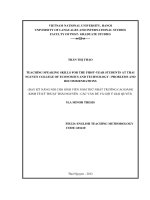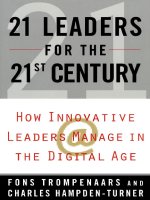Inventing the cloud century how cloudiness keeps changing our life, economy and technology
Bạn đang xem bản rút gọn của tài liệu. Xem và tải ngay bản đầy đủ của tài liệu tại đây (9.54 MB, 571 trang )
Marcus Oppitz and Peter Tomsu
Inventing the Cloud Century
How Cloudiness Keeps Changing Our Life, Economy and
Technology
Marcus Oppitz
Klosterneuburg, Austria
Peter Tomsu
Leitzersdorf, Austria
ISBN 978-3-319-61160-0 e-ISBN 978-3-319-61161-7
/>Library of Congress Control Number: 2017944452
© Springer International Publishing AG 2018
This work is subject to copyright. All rights are reserved by the Publisher, whether the whole or part
of the material is concerned, specifically the rights of translation, reprinting, reuse of illustrations,
recitation, broadcasting, reproduction on microfilms or in any other physical way, and transmission
or information storage and retrieval, electronic adaptation, computer software, or by similar or
dissimilar methodology now known or hereafter developed.
The use of general descriptive names, registered names, trademarks, service marks, etc. in this
publication does not imply, even in the absence of a specific statement, that such names are exempt
from the relevant protective laws and regulations and therefore free for general use.
The publisher, the authors and the editors are safe to assume that the advice and information in this
book are believed to be true and accurate at the date of publication. Neither the publisher nor the
authors or the editors give a warranty, express or implied, with respect to the material contained
herein or for any errors or omissions that may have been made. The publisher remains neutral with
regard to jurisdictional claims in published maps and institutional affiliations.
Printed on acid-free paper
This Springer imprint is published by Springer Nature
The registered company is Springer International Publishing AG
The registered company address is: Gewerbestrasse 11, 6330 Cham, Switzerland
To our wives, Irmgard and Tanja for their patience
And to our families
Preface
The idea for this book was formed in the spring of 2015. We were working for Cisco at that time, one
of the large players in network technology. Like every other company in the market, Cisco was on its
way to embrace the new opportunities generated by cloud computing and the Internet of Things.
Fascinated with bringing together the concept of cloud services and new network architectures to
create new business models, we started to work on a model involving different types of ownerships
to create a more precise definition of what cloud-based services could offer. The result was a first
initial publication; a short summary is part of the chapter entitled “Cloud Computing.” Soon we
discovered that we had touched the tip of an iceberg. Cloud computing and cloud services seemed to
be nothing more than the momentary status of an evolution that was started long ago and that was on
its way to change economy, technology, and society in an accelerating and dramatic way.
Both of us had started our careers as engineers in the mid-1970s at the University of Technology
Vienna at the time when computing and computer sciences began its journey toward a key technology
for businesses. Our working environment was dictated by mainframe computers, by punch cards, and
—if you were lucky—by very simple green-screen terminals. After university, we went on different
paths in our professional careers. Marcus started to work in the software business building own
companies and start-ups. Peter concentrated a great part of his professional life on the development
and deployment of new networking technologies and cloud architectures. When we met again, 40
years later, everything had changed completely. Computers went into the background; they became a
kind of commodity in your shirt pocket. Networks, the Internet, the Web, and Web-based services had
become the driving power for computer science, business, and society. Smart environments using
cognitive computing and the Internet of Things had started to disrupt many businesses and industry
segments. Digitalization had become a prerequisite for all kinds of organizations or corporations,
requiring the acceptance of new technologies but also creating a demand for change and transition of
business models. The social and political impact of social media pulled communities into the global
village and created many new challenges for politics and media. Within those 40 years, we had been
part of a huge transition starting with the first PCs and networks in the 1970s and moving to the
expansion of the Internet, to the revolution triggered by the Web, and to the concept of cloud
computing and cloud business today.
Those changes and transitions gained speed over the last decades and seem to point to a future
that would be influenced by the economy of cloud-based services. Exploring the path of this evolution
and trying projections into the future became a fascinating idea for both of us. There are Terabytes of
literature about technological developments, social and political impacts, and the rapidly changing
economy. What we had in mind is the interlock of these three dimensions to explore the making of
today’s cloud ecosystems as witnessed by followers of older service ecosystems that were based on
networks. We also wanted to describe the move of services to the cloud and the long-term trend that
is still progressing at high velocity. Successful technology is always accompanied by compelling
business models and ecosystems including private, public, and federal organizations. Our target was
to explore the evolution of service ecosystems, describe their similarities and differences, and
analyze the way they created and changed industries. Based on the status of cloud computing and
related technologies like virtualization, Internet of Things, fog computing, big data, and analytics, we
tried to provide an outlook into the possibilities of future technologies, the future of the Internet, and
the possible impacts on business and society moving to the cloud century.
This book is our result.
We address readers like engineers, historians, or economists who are interested in an
interdisciplinary view on the history, status, and future projection of the Internet, the Web, and cloud
computing. We aimed to connect the technical view with the economic history and the social effects
of service ecosystems based on networks. We have tried to follow a storytelling approach, moving
along the lines of historical evolution. While sometimes drilling down into technical details, this is
not a technical textbook.
Marcus Oppitz
Peter Tomsu
Vienna
2017
Abbreviations
10Base2 10 Mbps Baseband 200 meter
10Base5 10 Mbps Baseband 500 meter
10BaseT 10 Mbps Baseband Twisted Pair
3G Third generation of wireless mobile telecommunications technology
3GPP 3rd Generation Partnership Project
4G Fourth generation of mobile telecommunications standard
5G Fifth generation of wireless mobile telecommunications technology
AAL ATM Adaptation Layer
ACE Automatic Computing Engine
ACI Application Centric Infrastructure
ADSL Asymmetric Digital Subscriber Line
ALE Address Lifetime Expectations
ALU Arithmetic Logical Unit
AMD Advanced Micro Devices
ANSI American National Standards Institute
AOE ATA over Ethernet
API Application Program Interface
APIC Application Centric Infrastructure Controller
ARP Address Resolution Protocol
ARPA Advanced Research Projects Agency
ARPA IPTO Advanced Research Projects Agency Information Processing Techniques Office
ARPANET Advanced Research Projects Agency Network
AS Autonomous System
ASCII American Standard Code for Information Interchange
ASIC Application Specific Integrated Circuit
ATA Advanced Technology Attachment
ATM Asynchronous Transfer Mode
ATM Automated Teller Machine
AWS Amazon Web Services
BCF Big Cloud Fabric
BGP Border Gateway Protocol
B-ISDN Broadband Integrated Services Digital Network
BLE Bluetooth Low Energy
BNC Bayonett Neill Concelman
BUS Broadcaste and Unknown Server
CAD Computer Aided Design
CAF C++ Actor Framework
CBR Committed Bit Rate
CCITT Comité Consultatif International Téléphonique et Télégraphique
CD Compact Disk
CDMI Cloud Data Management Interface
CDPI Control to Data Plane Interface
CEP Complex Event Processing
CHS Cylinders Heads and Sectors
CIDR Classless Inter Domain Routing
CISC Complex Instruction Set Computing
CLI Command Line Interface
COBOL Common Business Oriented Language
COM Component Object Model
CORBA Common Object Request Broker Architecture
COTS Commercial Off The Shelf
CPS Cyber Physical System
CPU Central Processing Unit
CRC Cyclic Redundancy Check
CRM Customer Relationship Management
CRT Cathode Ray Tube
CRUD Create, Read, Update, Delete
CSMA/CD Carrier Sense Multiple Access with Collision Detection
CSNET Computer Science Network
DARPA Defense Advanced Research Projects Agency
DBMS Data Base Management System
DC Data Center
DCOM Distributed Component Object Model
DDS Data Distribution Service
DEC Digital Equipment Corporation
DHCP Dynamic Host Configuration Protocol
DHCPv6 Dynamic Host Configuration Protocol Version 6
DIX Digital Intel Xerox
DNS Domain Name System
DOD Department of Defense
DoS Denial of Service
DQDB Distributed Queue Dual Bus
DRAM Dynamic Random Access Memory
DSL Digital Subscriber Loop
DVD Digital Versatile Disc
EBCDIC Extended Binary Coded Decimal Interchange Code
EC-GSM-IoT Extended Coverage GSM for IoT
EGPRS Enhanced General Packet Radio Service
ELAN Emulated LAN
ERP Enterprise Resource Planning
ESCON Enterprise System Connection
ESG Enterprise Study Group
ESX Elastic Sky X
FC Fiber Channel
FCOE Fiber Channel Over Ethernet
FDDI Fiber Distributed Data Interface
FIB Forwarding Information Base
FICON Fiber Connection
FLOPS Floating Point Operations Per Second
FPGA Field Programmable Gate Array
FTP File Transfer Protocol
FTTH Fiber To The Home
GC&CS Government Code and Cypher School
GE General Electric
GFC Generic Flow Control
GFLOPS Giga Floating Point Operations per Second
GIG Global Information Grid
GMO Genetecally Modified Organism
GMR Giant Magneto Resistive
GNSS Global Navigation Satellite System
GNU GNU’s not Unixe
GPL General Public License
GPRS General Packet Radio Service
GPS Global Positioning System
GRE Generic Route Encapsulation
GSM Global System for Mobile Communications
GSMA Global System Mobile Association
GUI Graphical User Interface
HA High Availability
HC Hop Count
HCC Homebrew Computer Club
HDFS Hadoop Distributed File System
HEC Header Error Correction
HMI Human Machine Interface
HPC High Performance Computing
HRMS Human Resource Management System
HSM Hierarchical Storage Management
HSPA High Speed Packet Access
HTTP Hyper Text Transfer Protocol
IaaS Infrastructure as a Service
IBM International Business Machines
IC Incubation Committee
ICMPv6 Internet Control Message Protocol Version 6
IDC International Data Corporation
IEEE Institute of Electrical and Electronics Engineers
IETF Internet Engineering Task Force
IGP Interior Gateway Protocol
IIoT Industrial Internet of Things
Intel VT Intel Virtualization Technology
IoE Internet of Everything
IoT Internet of Things
IOTC Internet of Things Consortium
IoTSF IoT Security Foundation
IoTWF Internet of Things World Forum
IP Internet Protocol
IPng IP Next Generation
IPU Instruction Processing Unit
IPv4 Internet Protocol Version 4
IPv6 IP Version 6
iscsi Internet Small Computer System Interface
ISDN Integrated Services Digital Network
ISIS Intermediate System to Intermediate System
ISM Industrial Scientific and Medical
ISO International Standards Organization
ISP Internet Service Provider
IT Information Technology
ITS Intelligent Transportation System
ITU International Telecommunication Union
ITU-T Telecommunication Standardization Sector of the International Telecommunications Union
IXP Internet Exchange Point
KVM Kernel Virtual Machine
LAN Local Area Network
LANE LAN Emulation
LBA Logical Block Addressing
LCD Liquid Crystal Display
LDAP Lightweight Directory Access Protocol
LEC LAN Emulation Client
LECS LAN Emulation Client Server
LED Light Emitting Diode
LES LAN Emulation Server
LPWA Low-Power Wide Area
LTE Long Term Evolution
LTE-M Long Term Evolution for Machines
LTE-MTC LTE optimized for advanced Machine Type Communications
LUN Logical Unit Numbers
M2M Machine to Machine
MAC Media Access Control
MAN Metropolitan Area Network
MAP Manufacturing Automation Protocol
MAU Medium Access Unit
MHS Message Handling System
MI6 Military Intelligence, Department 6
MIPS Millions Instructions Per Second
MIT Massachusetts Institute of Technology
MMU Memory Management Unit
MP3 MPEG-1 and/or MPEG-2 Audio Layer III
MPLS Multi Protocol Label Switching
MQTT Message Queue Telemetry Transport
MRAM Magnetic Random Access Memory
MTU Maximum Transmission Unit
NAP Network Access Point
NAS Network Attached Storage
NASA National Aeronautic And Space Administration
NAT Network Address Translation
NBI North Bound Interface
NB-IoT Narrow Band IoT
NCP Network Control Program
NCR National Cash Register
NDP Neighbor Discovery Protocol
NFC Near Field Communication
NFV Network Function Virtualization
NIC Network Interface Card
NLRI Network Layer Reachability Information
NNI Network Network Interface
NoSQL Non Relational Structured Query Language
NSAP Network Service Access Point
NSCI National Strategic Computing Initiative
NSF National Science Foundation
NSFNet National Science Foundation Network
NSX VMware NSX Network Virtualization
NVP Network Virtualization Platform
OAM Operations Administration Maintenance
OCP Open Compute Project
ODL OpenDaylight
OEM Original Equipment Manufacturer
OMG Object Management Group
ONF Open Networking Foundation
ONIE Open Network Install Environment
ONL Open Network Linux
OPC Open Platform Communication
OPEX Operating Expense
OS Operating System
OSI Open Systems Interconnection
OSS Operational Support System
OT Operations Technology
OVF Open Virtualization Format
P2P Peer to Peer
PAC Programmable Automation Controller
PC Personal Computer
PCM Phase Change Memory
PDH Plesiochronous Digital Hierarchy
PDU Protocol Data Unit
PFE Packet Forwarding Engine
PGP Pretty Good Privacy
PLC Programmable Logic Controller
PLS Physical Layer Signalling
PMA Physical Medium Attachment
PNNI Private Network to Network Interface
PSTN Public Switched Telephone Network
PT Payload Type
PVC Permanent Virtual Circuit
QoS Quality of Service
QuAIL Quantum Artificial Intelligence Laboratory of NASA
RAID Redundant Array of Independent Disks
RAM Random Access Memory
RCA Radio Corporation of America
RDBMS Relational Data Base Management System
REST Representational State Transfer
RFC Request for Comments
RFID Radio Frequency IDentification
RIB Routing Information Base
RISC Reduced Instruction Set Computing
ROM Read Only Memory
RSA Rivest, Shamir and Adleman Encryption
SAN Storage Area Network
SAP Systems, Applications, Products
SCADA Supervisory Control and Data Acquisition
SCV Smart Connected Vehicle
SD Secure Digital
SDDC Software Defined Data Center
SDH Synchronous Digital Hierarchy
SDK Software Development Kit
SDN Software Defined Networking
SDS Software Defined Storage
SIMD Single Instruction Multiple Data
SLA Service Level Agreement
SLAAC Stateless Address Auto Configuration
SMTP Simple Mail Transfer Protocol
SNA Systems Network Architecture
SNIA Storage Networking Industry Association
SNMP Simple Network Management Protocol
SOAP Simple Object Access Protocol
SONET Synchronous Optical Network
SQL Structured Query Langage
SSH Secure Shell
SSL Secure Sockets Layer
STL Smart Traffic Light
STP Spanning Tree Protocol
STS Supranet Transaction Server
STSL Smart Traffic Light System
STT-RAM Spin Transfer Torque Random Access Memory
SVC Switched Virtual Circuit
TCP Transmission Control Protocol
TCP/IP Transmission Control Protocol/Internet Protocol
TEPS Traversed Edges Per Second
TOR Top Of Rack
TRILL Transparent Interconnection of Lots of Links
TSN Time Sensitive Networking
TTL Time To Live
UCLA University of California Los Angeles
UDP User Datagram Protocol
UML User Mode Linux
UNI User Network Interface
UNIX Family of multitasking, muktiuser computer operating systems
USENIX The Advanced Computing Systems Association
UTF-8 UCS (Universal Character Set) Transformation Format
UUCP Unix-to-Unix-Protocol
VBR Variable Bit Rate
VC Virtual Circuit
VCI Virtual Circuit Identifier
VDS vSphere Distributed Switch
VDSL Very High Bit Rate Digital Subscriber Line
VLAN Virtual LAN
VM Virtual Machine
VMM Virtual Machine Monitor
VNI Visual Networking Index
VP Virtual Path
VPI Virtual Path Identifier
VPN Virtual Private Network
VSS vSphere Standard Switch
W3C World Wide Web Consortium
WAN Wide Area Network
WiFi Trademark of the WiFi Alliance for wireless local area networking
WLAN Wireless LAN
WPAN Wireless Personal Area Network
WPS Word Processing System
WSAN Wireless Sensor and Actuator Network
XEN Linux Foundation Collaboration Projects
Xerox PARC Xerox Palo Alto Research Center
XML Extended Markup Language
Contents
Introducing Cloudiness
In Search for a Better Life
Service Ecosystems: The Five Magic Elements
Creation and Innovation
Structure of the Book
References
A Short History of Service Ecosystems
Cloud: An Old Concept
Water
Public Transport and Postal Services
The First Transport Networks
International Rollout
Business and Market Today
Social Impact
Railway
Technology 1.0: The Steam Age
Technology 2.0: Electricity, Diesel and High-Speed
Social and Economic Impact
References
Early Information Network Services
The First Optical Communication Network
Social and Economic Impact
The Electric Telegraph
Social and Economic Impact
Telephone
Technology
Building an Ecosystem
Social and Economic Impact
Wireless
Technology
Building Business: The Begin of the Electronic Industry
Standards
Broadcasting
Technology
Building Radio Business
Standards and Regulation
Social Impact
Status Before Internet and Cloud Computing
References
Making of Digital Computers
History of Computing
From Mechanical to Electrical Computing
1928–1936: Mathematical Theory—Gödel, Turing and von Neumann
1936 The Turing Machine
Von Neumann Architecture
Women and the Development of Computers
The Birth of IBM: The Mother of Mainframes
1960 Mainframes and Early Computing
Early User Interfaces
Mainframe and Virtualization
The Big Mainframe Players
1970 The Rise of Minicomputers
1980 Personal Computers
The Homebrew Computer Club
Computers from the Starting Period
1977 Apple II: The First Personal Computer for Everyone
The Rise of PCs
1980 From Personal Computers to Workstations
1990 PCs Getting Mature
1990s Servers Replacing Mainframes
2010 Mainframes Renaissance
Supercomputers Versus Modern Mainframes
Mainframes in the Middle of the 2010s
The Economic Cloud Solution
References
Networks for Sharing and Connecting
Evolution of Computer Networks
Ethernet: The Epic Foundation for Local Area Networks
Other Local Area Network Standards
From Ethernet to Structured Cabling
Principles of Layered Networking
Bridges Expanding LANs Beyond Cabling Limitations
Switches Enabling Scalable Fast Networking
Routers and Cisco
Networking Standards
The Birth of Modern Networking
The Internet Protocol Suite
Internet Protocol Suite Layers Defined
OSI Reference Model
ATM: Attempt to Integrate Data and Voice
The Success of the Internet Protocol Suite
Internet Protocol Next Generation aka IPv6
IPng/IPv6 Advancements
IPv6 Packet Format
IPv6 Deployment
References
Managing Virtual Storage
Shared Storage Model
Different Types of Storage Virtualization
Disk Virtualization
Tape Storage Virtualization
File System Virtualization
File/Record Virtualization
Block Virtualization
References
From Physical to Virtual Servers
Server Virtualization Overview
Server Virtualization Methods in Detail
Open Virtualization Format (OVF)
References
Software Defined Virtual Networks
Some SDN History and Evolution
Legacy Networking Limitations Driving SDN
SDN Disrupting Legacy Networking
Concept and Promise of SDN
High Level View of SDN
Centralized Versus Distributed Control and Data Planes
Control Plane
Forwarding and Data Plane
Separation of Control and Data Planes
Different Functional Planes of Network Elements
Evolution of Control Plane Concepts
Open SDN Implementations
OpenFlow
OpenDaylight (ODL)
Open Compute Project (OCP)
SDN Market and Implementations
VMware and Nicira
Cisco ACI: Application Centric Infrastructure
Big Switch Networks
References
Building the Internet
Preparations
Connecting Machines and People
Building the Basement: Unix and C
Open Systems
Rollout of the Internet
Connecting to the Internet
The First Communities
The Commercialization of the Internet
The IT Market at the End of the 1980s
The Internet Before the Web
Reference
World Wide Web
The World Wide Web Is Born
Browsers
Sharing Pictures, Music and Video
Starting with Web Portals and Search
Improving Efficiency: Java, PHP and Web Services
Building First Businesses
Starting with e-Commerce
Smart Search: Google and Followers
Free Content
The Dot-com Bubble
The IT Market in the Early 2000s
Web 2.0 and the Social Networks
Travel
Social Media: Facebook and Others
Pictures, Music and Video
Mobile and Smart
The IT Market in 2005
Leaving the Desk
A Disruptive Business Model for Software
The IT Market in 2010
Reference
Cloud Computing
What Is Cloud Computing?
Similarities and Differences to Other Service Ecosystems
Definitions of Cloud Computing
The Official NIST Definition
The ITU Cloud Reference Architecture
The Ownership Model
Native Cloud Applications
Moving Towards the Clouds
Infrastructure as a Service
Software as a Service
Office as a Service
Chat, Collaboration and Video
New Business Models for Media
New Business Models for Sharing Resources
Social Networking 2
Sharing Knowledge and Information
References
Building Cloud Businesses and Ecosystems
Business Models
Basic Assumptions
Drivers of Acceptance
Obstacles
Enablers
Primary Cloud Infrastructure and Cloud Service Business
Cloud Infrastructure
Cloud Services
Secondary Markets
E-Commerce
Advertising
Travel and Online Booking
Media and Entertainment
Cloud Market Players
IT Companies
Internet Companies
Semiconductor and Electronics Manufacturers
Infrastructure
Standards and Standard Organizations
Open Source Software
Creating Innovation
Creative Destruction and Disruption
Technology, Paradigms and Ecosystems
The Importance of Paradigm Changes
Acceleration of Paradigm Changes
14 Major Paradigm Changes Since 1950
Innovation as Business
The Innovation Ecosystem
Founders
Investors
Regions and Hotspots
Silicon Valley as Unique Model for Innovation
Innovation’s Effects
New Jobs
Quick Success or Fail
Innovation Accelerates Productivity
Delayed Effect on Economy
Reference
Security and Privacy Challenges
Good, Bad and Ugly
A Short History of Private Communication: Secret Messages
Machines for Encryption and Decryption
Going Industrial: Standard Technology
Building Secure Connections for the Internet
Creating Standards and Best Practices
Security Today
Cloud Security Threats and Typical Patterns
Security Market
Threat Agents and Their Motivations
Hackers
Whistleblowers
Cyberwarfare
Industrial Espionage
Cybercrime
Data Theft
Ransomware
Fake Emails
Phishing Mails
CEO Fraud
Dark Web and Deep Web
The Growth of Cybercrime
Defense and Security Policies on Different Levels
Reference
Changes in Society and Politics









